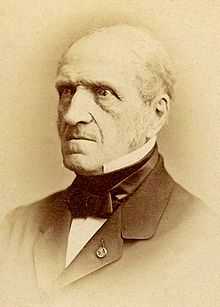Michel Chasles
| Michel Chasles | |
|---|---|
 Michel Chasles | |
| Born |
15 November 1793 Épernon, France |
| Died |
18 December 1880 (aged 87) Paris |
| Nationality | French |
| Fields | Mathematics |
| Doctoral advisor | Siméon Denis Poisson |
| Doctoral students |
Jean Gaston Darboux Hubert Anson Newton |
| Notable awards | Copley Medal (1865) |
Michel Floréal Chasles (15 November 1793 – 18 December 1880) was a French mathematician.
He was born at Épernon in France and studied at the École Polytechnique in Paris under Siméon Denis Poisson. In the War of the Sixth Coalition he was drafted to fight in the defence of Paris in 1814. After the war, he gave up on a career as an engineer or stockbroker in order to pursue his mathematical studies.
In 1837 he published his Historical view of the origin and development of methods in geometry, a study of the method of reciprocal polars in projective geometry. The work gained him considerable fame and respect and he was appointed Professor at the École Polytechnique in 1841, then he was awarded a chair at the Sorbonne in 1846. A second edition of his book was published in 1875, and Leonhard Sohncke translated the work into German.
Jakob Steiner had proposed the problem of enumerating the number of conic sections tangent to each of five given conics, and had answered it incorrectly. Chasles developed a theory of characteristics that enabled the correct enumeration of the conics (there are 3264) (see enumerative geometry). He established several important theorems (all called Chasles' theorem). In kinematics, Chasles' description of a Euclidean motion in space as screw displacement was seminal to the development of the theories of dynamics of rigid bodies.
In 1865 he was awarded the Copley Medal.
As described in A Treasury of Deception, by Michael Farquhar (Peguin Books, 2005), between 1861 and 1869 Chasles purchased over 27,000 forged letters from Frenchman Denis Vrain-Lucas. Included in this trove were letters from Alexander the Great to Aristotle, from Cleopatra to Julius Caesar, and from Mary Magdalene to a revived Lazarus, all in a fake medieval French. In 2004, the journal Critical Inquiry published a recently "discovered" 1871 letter written by Vrain-Lucas (from prison) to Chasles, conveying Vrain-Lucas's perspective on these events,[1] itself an invention.[2]
In 1986, Alexander Jones published a commentary on Book 7 of the Collection of Pappus of Alexandria, which Chasles had referred to in his history of geometric methods. Jones makes these comments about Chasles, Pappus and Euclid:[3]
- Chasles's contribution to our comprehension of the Porisms tends to be obscured by the inherent unreasonableness of his claim to have restored substantially the contents of Euclid's book on the basis of the meagre data of Pappus and Proclus...one still turns to Chasles for the first appreciation of the interest in the Porisms from the point of view of modern geometry. Above all, he was the first to notice the recurrence of cross-ratios and harmonic ratios in the lemmas, and because these concepts suffuse most of his restoration, it is probable that many of his inventions coincide with some of Euclid's, even if we cannot now tell which they are.
Chasles' name is one of the 72 names inscribed on the Eiffel Tower.
Publications
- Chasles, M. (1831). "Note sur les propriétés générales du système de deux corps semblables entr'eux". Bulletin des Sciences Mathématiques, Astronomiques, Physiques et Chemiques (in French) 14: 321–326.
- M. Chasles (1837) Aperçu historique sur l'origine et le développement des méthodes en géométrie, originally published by Hayez in Bruxelles, now from archive.org.
- M. Chasles (1841) Two geometrical memoirs on the general properties of cones of the second degree, and other spherical conics, Charles Graves translator, originally published in Dublin, now from Cornell University.
- M. Chasles (1865) Traité des sectiones-coniques, Gauthier-Villars, from University of Michigan.
- M. Chasles (1852, 1880) Traité de Géométrie Supérieure, Gauthier-Villars, from Google.
See also
- Chasles–Cayley–Brill formula
- Chasles' theorem (kinematics)
- Asteroid 18510 Chasles
Notes
- ↑ Ken Alder, "History's Greatest Forger: Science, Fiction, and Fraud Along the Seine," Critical Inquiry 30 (Summer 2004):704-716.
- ↑ Anne H. Stevens, Forging Literary History: Historical Fiction and Literary Forgery in Eighteenth-Century Britain, Studies in Eighteenth-Century Culture: Volume 37, Johns Hopkins University Press, Mar 18, 2008.
- ↑ Alexander Jones (1986) Book 7 of the Collection, part 1: introduction, text, translation ISBN 0-387-96257-3, part 2: commentary, index, figures ISBN 3-540-96257-3, Springer-Verlag
References
- O'Connor, John J.; Robertson, Edmund F., "Michel Chasles", MacTutor History of Mathematics archive, University of St Andrews.
- Michel Chasles at the Mathematics Genealogy Project
|